Abacus Data Ontario Poll: PCs Steady at 52% as Crombie Resigns Amid Liberal Convention Fallout
September 23, 2025
As Ontario politics enters a period of leadership turbulence for the opposition, Doug Ford and the Progressive Conservatives maintain their dominant grip on the electorate. The latest Abacus Data survey, conducted over the weekend of the Ontario Liberal Party’s leadership review convention, shows the PCs holding steady at 52% of the vote—only one point below their all-time high in our tracking – while the Liberals see their support drop and Bonnie Crombie exits the political stage.
This wave captures a rare moment of volatility: interviews were split almost evenly between the days before and after Crombie’s resignation, allowing a unique glimpse into voter sentiment amid political upheaval. Despite the drama, the results underscore a recurring theme: Ford and the PCs are not just ahead, they are way ahead.
Vote Intention: PCs Maintain 52%, Liberal Slide Accelerates
If a provincial election were held today, 52% of committed voters would cast their ballot for the Progressive Conservatives, down just one point since August. The Ontario Liberals have fallen to 24%, a three-point drop in the same period. The NDP holds steady at 12%, while the Greens are at 6%.
This 28-point lead over the Liberals is the largest margin since our tracking began. After months of slow erosion, the Liberal brand has now lost six points since May and shows signs of further deterioration, particularly in regions where the party had been moderately competitive.
For the PCs, this month’s data confirms a stable coalition that has weathered affordability pressures and economic uncertainty. Their support base appears deeply embedded across regions and demographic segments, suggesting the party is benefiting from both Ford’s personal brand and the vacuum of credible opposition.
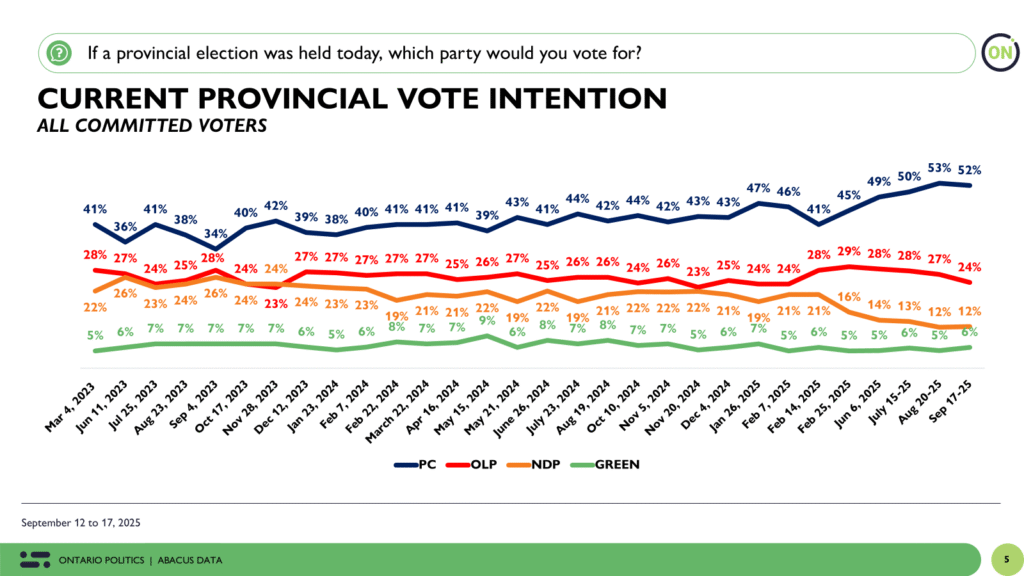
PCs Dominate Regionally and Across Key Demographics
The Progressive Conservatives continue to lead across all major regions of the province. In Toronto, they are ahead of the Liberals by 24 points (52% to 28%). In the GTHA, the PCs lead by 22 points, while in Southwestern Ontario, they now command a 42-point margin over the Liberals (60% to 18%).
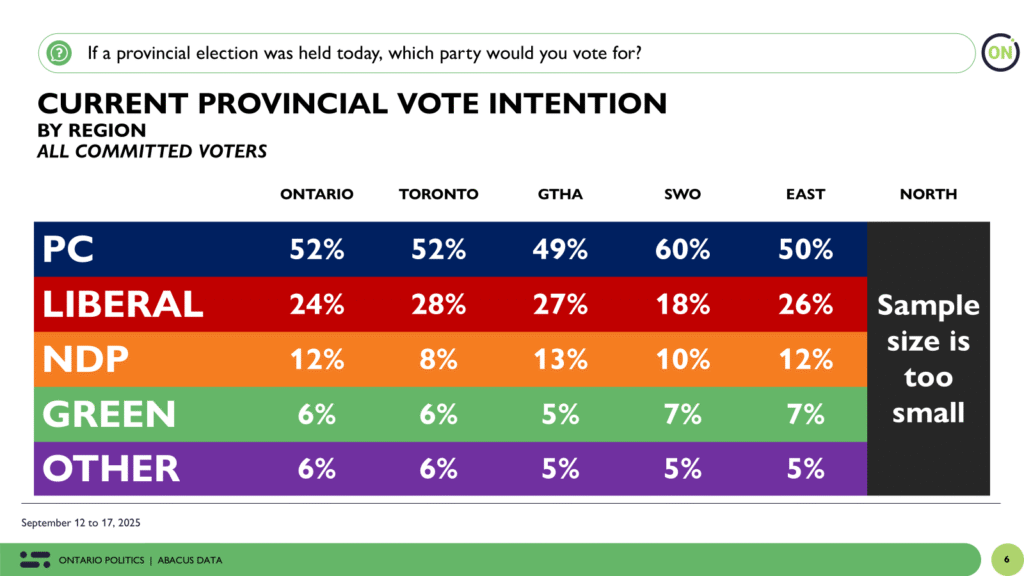
The demographic map is equally telling. The PCs lead among both men and women, and among every age, including those aged 18 to 29.
What stands out is the breadth of the PC coalition. Unlike the Liberals or NDP, whose bases are more narrowly distributed, Ford’s party continues to win support from all corners of the province and all walks of life.
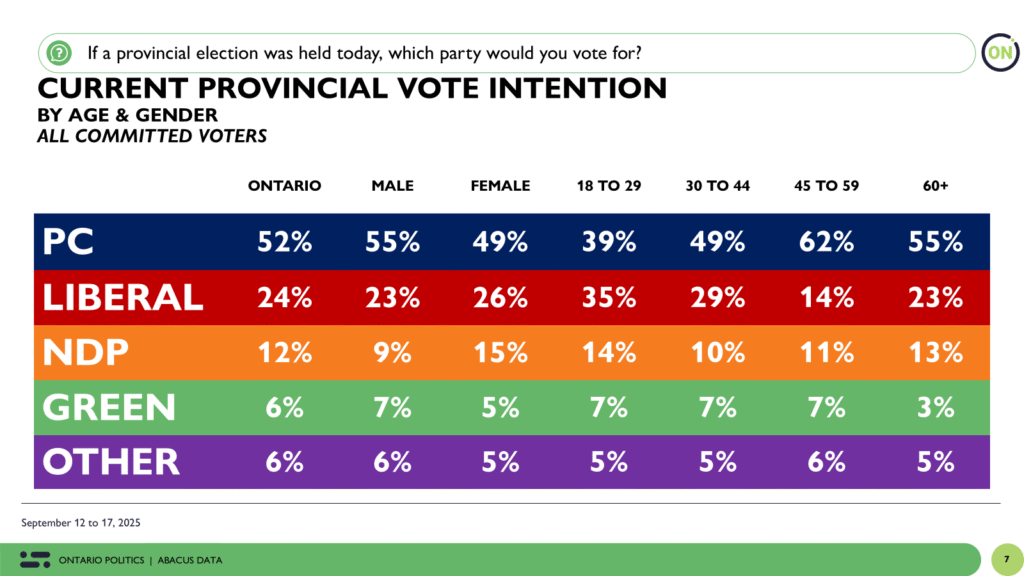
Approval: Ford Government Still in Positive Territory
Public satisfaction with the Ford government remains largely unchanged. Forty-seven percent of Ontarians approve of the job Ford and his team are doing, while 31% disapprove. This net +16 is marginally lower than the +18 recorded in August, but still among the most favourable ratings Ford has received since our tracking began in 2023.
The Ford government’s approval numbers have been in positive territory since the beginning of the year, a period initiated by Trump’s inauguration.
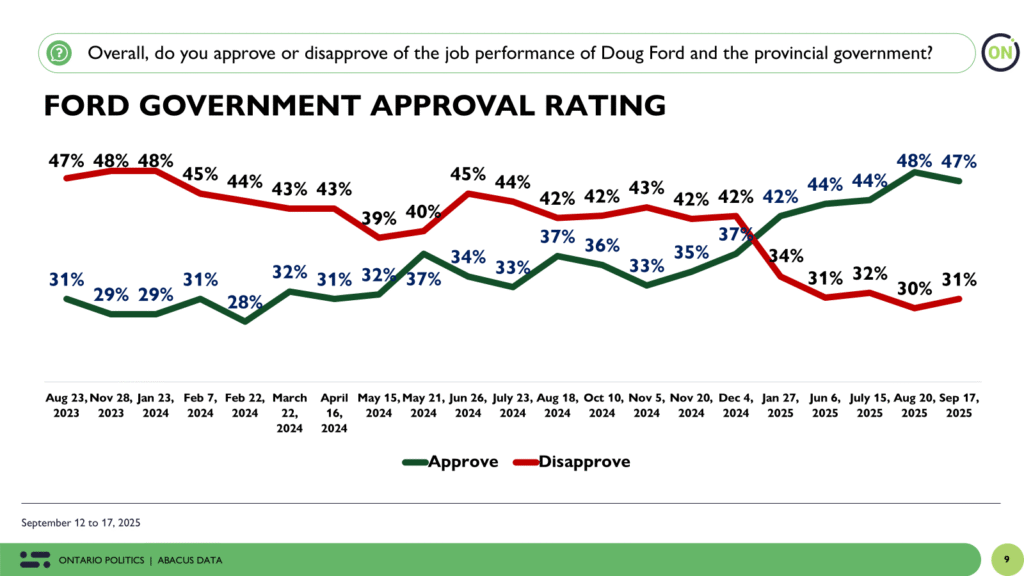
Leadership Impressions: Ford Up, Crombie Down
Doug Ford remains the most positively viewed political leader in Ontario, with 46% of Ontarians holding a favourable impression of him, 33% unfavourable, and just 1% unsure—a net impression of +13.
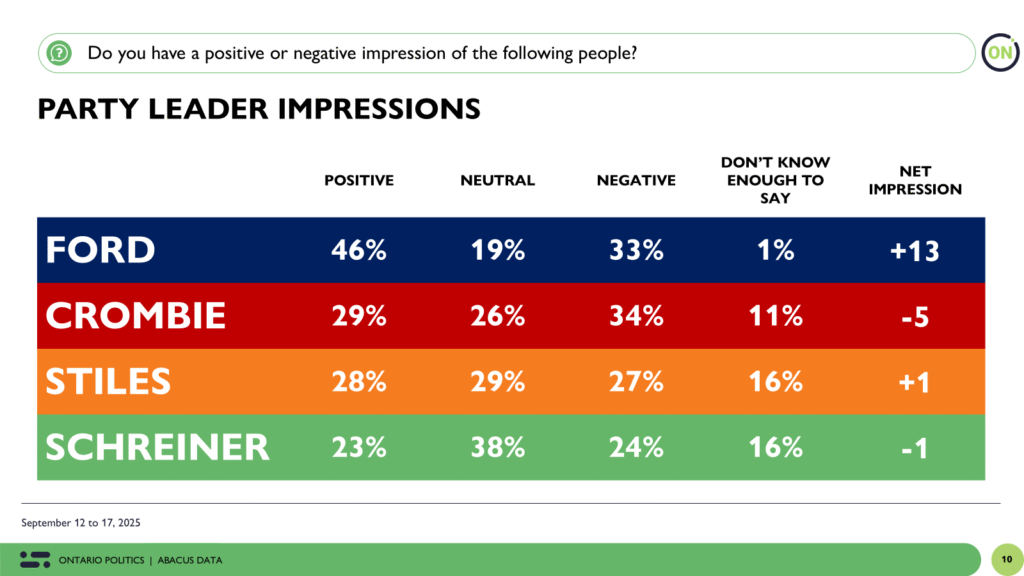
Bonnie Crombie, by contrast, ends her tenure as Liberal leader with a net impression of -5, down from -3 last month. Only 29% view her positively, while 34% view her negatively, and 11% say they don’t know enough to offer a view. Her resignation comes amid declining personal numbers and a party brand that has stalled despite earlier optimism.
Marit Stiles’s impression is stable, now sitting at +1 overall. Mike Schreiner’s net score remains slightly negative at -1, consistent with previous months.
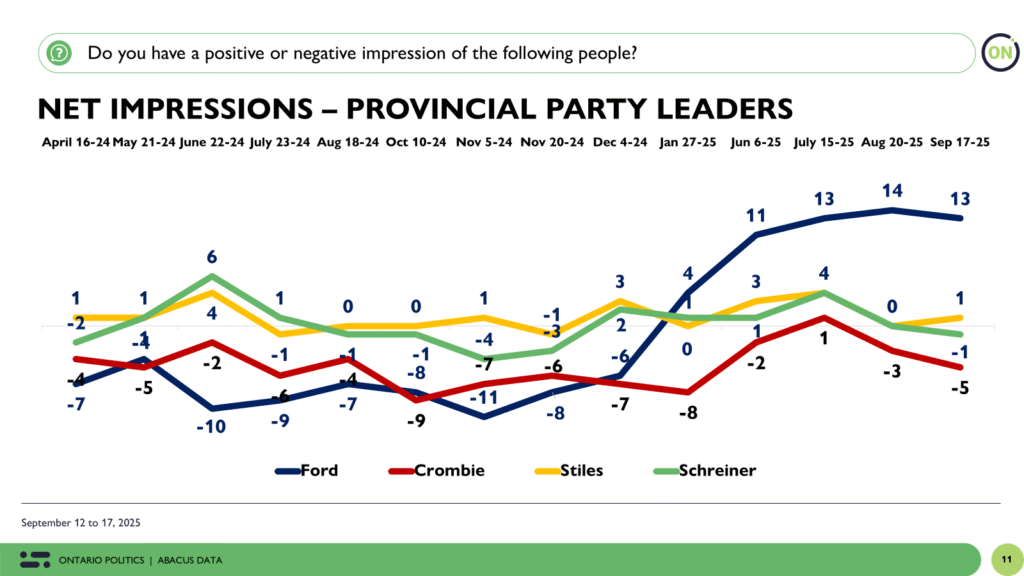
Preferred Premier: Ford Dominates Post-Crombie Landscape
Doug Ford is the preferred choice for Premier among 46% of Ontarians, unchanged from August. Crombie, even as she stepped down, attracted the support of just 18%, while Stiles trails at 12% and Schreiner at 6%. Another 18% remain undecided.
Ford leads in every major region and across almost every demographic segment. He is preferred by a majority of men (51%) and a plurality of women (42%). Among those aged 45 to 59, he reaches 53%, and among those 60 and older, he holds steady at 50%. Even among younger voters aged 18 to 29, a group typically more hostile to Ford, he registers 33%, ahead of both Crombie (25%) and Stiles (12%).
This widespread appeal underscores the strength of his leadership brand: well-known, broadly accepted, and largely unchallenged.
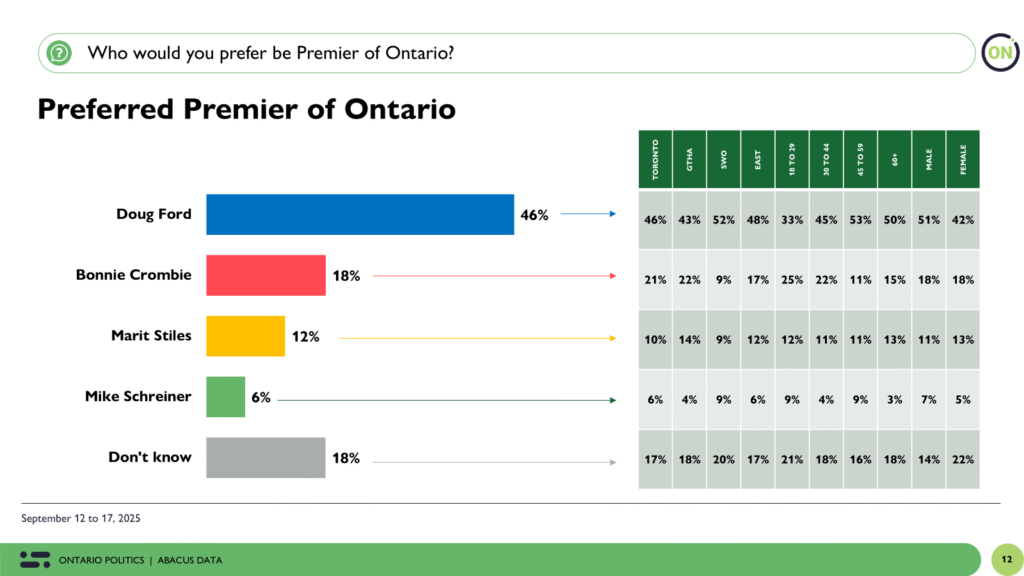
The Upshot
This survey was conducted during a moment of significant political drama. The Ontario Liberal Party convention, marked by internal tension and Bonnie Crombie’s resignation, reflects a party in transition. The data suggest that many voters are tuning out, as Liberal support has eroded and Crombie’s personal brand has weakened.
Doug Ford, by contrast, remains a picture of stability, unmoved by the noise, and bolstered by broad, cross-demographic appeal. With a 28-point lead over the Liberals, majority approval, and unmatched name recognition, Ford and the PCs head into the fall on solid footing.
The NDP, still facing internal uncertainty ahead of their own convention, have yet to present a compelling alternative overshadowed by the weak national party brand. Their vote share remains flat, and Stiles continues to face significant recognition barriers.
Looking ahead, affordability, economic uncertainty, and leadership remain the dominant voter concerns. Right now, Ford is winning on all three.
Methodology
The survey was conducted with 1,021 eligible voters in Ontario from September 12 to 17, 2025.
A random sample of panelists were invited to complete the survey from a set of partner panels based on the Lucid exchange platform. These partners are typically double opt-in survey panels, blended to manage out potential skews in the data from a single source.
The margin of error for a comparable probability-based random sample of the same size is +/- 3.1%, 19 times out of 20.
The data were weighted according to census data to ensure that the sample matched Ontario’s population according to age, gender, educational attainment, and region. Totals may not add up to 100 due to rounding.
This survey was paid for by Abacus Data Inc.
Abacus Data follows the CRIC Public Opinion Research Standards and Disclosure Requirements that can be found here: https://canadianresearchinsightscouncil.ca/standards/
ABOUT ABACUS DATA
We are Canada’s most sought-after, influential, and impactful polling and market research firm. We are hired by many of North America’s most respected and influential brands and organizations.
We use the latest technology, sound science, and deep experience to generate top-flight research-based advice to our clients. We offer global research capacity with a strong focus on customer service, attention to detail, and exceptional value.
And we are growing throughout all parts of Canada and the United States and have capacity for new clients who want high quality research insights with enlightened hospitality.
Our record speaks for itself: we were one of the most accurate pollsters conducting research during the 2021 Canadian election following up on our outstanding record in the 2019, 2015, and 2011 federal elections.
Contact us with any questions.
Find out more about how we can help your organization by downloading our corporate profile and service offering.




